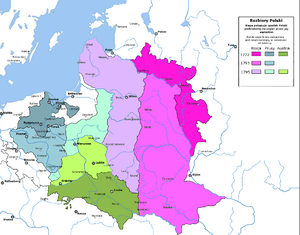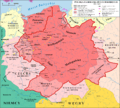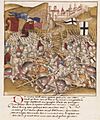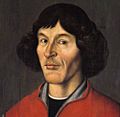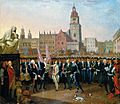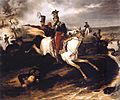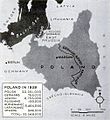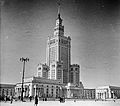History of Poland facts for kids
The History of Poland tells the story of how its lands have changed over the last 1000 years. In the 1500s, the Polish-Lithuanian Commonwealth was one of Europe's biggest countries, second only to Russia. At other times, Poland didn't even exist as its own country.
Poland became independent again in 1918, after being ruled by other empires for over 100 years. Its borders changed once more after World War II.
Contents
How Poland Began
Poland started to become a country in the mid-900s. It was led by the Piast family, a powerful dynasty of rulers. In 966, Prince Mieszko I and the Polish people became Christian. This was a very important step for the new nation.
In the 1100s, Poland split into several smaller states. These states were later attacked by Mongol armies in 1241. In 1320, Władysław I became king and brought Poland back together. His son, Casimir III, improved Poland's economy. He also built new castles and won a war against the Ruthenian dukedom.
The terrible Black Death plague, which affected much of Europe from 1347 to 1351, did not reach Poland.
The Polish-Lithuanian Commonwealth
Starting with the Lithuanian Grand Duke Jogaila, the Jagiellon dynasty (1385–1569) created the Polish-Lithuanian Union. This partnership was good for both Poles and Lithuanians. They became a major power in Europe for the next 300 years.
In 1505, a law called Nihil novi was passed by the Polish Sejm (parliament). This law gave most of the law-making power to the Sejm, not the king. This period was known as the "Nobility Commonwealth." The country was ruled by "free and equal" Polish nobles called szlachta.
The Union of Lublin in 1569 officially formed the Polish-Lithuanian Commonwealth. This made Poland a very important player in European politics and a center for culture.
Conflicts with Neighbors
In the 1600s, Sweden attacked all of Poland in a period known as "the Deluge." Poland also fought many wars against the Ottoman Empire, Russia, and other neighbors. These wars ended with a peace treaty in 1699.
Over the next 80 years, Poland's government became weaker. This made Poland dependent on Russia. Russian leaders, called tsars, used money to influence Polish traitors. These traitors would block new ideas and solutions.
Poland is Divided
Russia, Prussia, and Austria decided to divide Poland among themselves. This happened in three stages: 1772, 1793, and 1795. These divisions completely dissolved the country. Polish people did not like being ruled by new kings and often rebelled.
A New Constitution
In 1791, the Polish and Lithuanian parliament tried to make reforms. They accepted the Constitution of May 3. This was the first modern constitution in Europe and the second in the world, after the United States. However, this did not stop the partitions of Poland in 1793 and 1795.
After Napoleon's Wars
Napoleon created another Polish state called the "Duchy of Warsaw." But after the Napoleonic Wars, Poland was divided again by other countries at the Congress of Vienna. The eastern part of Poland was then ruled by the Russian tsar.
World War I and Independence
During World War I, the Western Allies agreed that Poland should be an independent country. Soon after Germany surrendered in November 1918, Poland became the Second Polish Republic. It gained its freedom after several military conflicts. The biggest was the Polish–Soviet War from 1919 to 1921.
World War II and Its Impact
On September 1, 1939, Nazi Germany attacked Poland. The Soviet Union attacked on September 17. Warsaw was defeated on September 28. Poland was then split into two parts, one controlled by Nazi Germany and the other by the Soviet Union.
Poland lost the highest number of people of all the countries in the war. Over 6 million Poles died, and half of them were Polish Jews. Poland also provided many troops to help defeat Nazi Germany. Only the US, British, and Soviet forces had more soldiers.
At the end of the war, Poland's borders were moved west. The eastern border moved to the Curzon line, and the western border moved to the Oder-Neisse line. The new Poland became about 20% smaller. This shift forced millions of people to move, including Poles, Germans, Ukrainians, and Jews.
After these events, Poland became a more unified country. Many Poles still live in neighboring countries like Ukraine, Belarus, and Lithuania. The largest group of Poles outside Poland lives in the United States, especially in Chicago.
The Soviet Era
After World War II, the Soviet Union set up a Communist government in Poland. The country was then called the People's Republic of Poland. In 1989, Solidarity, a political group led by Lech Wałęsa, helped to defeat the Communist government in Poland.
Post-Communism and the EU
In the early 1990s, Poland's economy became one of the strongest in Central Europe. There were many improvements in human rights, including free speech and democracy. In 1991, Poland joined the Visegrad Group. It then joined NATO in 1999, along with the Czech Republic and Hungary.
Polish voters decided to join the European Union in a vote in June 2003. The country officially joined the EU on May 1, 2004.
Images for kids
-
Reconstructed Biskupin fortified settlement of the Lusatian culture, 8th century BC
-
Poland expanded under its first two rulers. The dark pink area represents Poland at end of rule of Mieszko I (992), whereas the light pink area represents territories added during the reign of Bolesław I (died 1025). The dark pink area in the northwest was lost during the same period.
-
A representation of the Battle of Grunwald, a great military contest of the Late Middle Ages
-
King Casimir IV Jagiellon was the central figure of the Jagiellonian period
-
Nicolaus Copernicus formulated the heliocentric model of the solar system that placed the Sun rather than the Earth at its center
-
The Italian courtyard at Wawel Castle in Kraków, the former seat of Polish monarchs
-
The Polish–Lithuanian Commonwealth at its greatest extent, after the Truce of Deulino of 1619
-
Henry de Valois, later Henry III of France, was the first elected Polish king in 1573
-
Sigismund III Vasa enjoyed a long reign, but his actions against religious minorities, expansionist ideas and involvement in dynastic affairs of Sweden, destabilized the Commonwealth.
-
King John III Sobieski with his son Jakub, whom he tried to position to be his successor. Sobieski led the Commonwealth to its last great military victories.
-
Augustus II the Strong, the first Saxon ruler of Poland. His death sparked the War of the Polish Succession.
-
Stanisław August Poniatowski, the "enlightened" monarch
-
Tadeusz Kościuszko's call for a national uprising, Kraków 1794
-
The three Partitions of the Polish–Lithuanian Commonwealth (1772, 1793, and 1795)
-
The death of Józef Poniatowski, Marshal of the French Empire, at the Battle of Leipzig
-
Napoleon Bonaparte establishing the Duchy of Warsaw under French protection, 1807
-
The capture of the Warsaw arsenal at the beginning of the November Uprising of 1830
-
Romuald Traugutt, the last supreme commander of the 1863 Uprising
-
Bolesław Prus (1847–1912), a leading novelist, journalist and philosopher of Poland's Positivism movement
-
Many Jews emigrated from the Polish–Lithuanian lands in the late 19th and early 20th centuries, but most remained to form a large ethnic minority
-
Marie Curie, discoverer of radioactive elements
-
Rosa Luxemburg, leader of the Social Democracy of the Kingdom of Poland and Lithuania
-
Roman Dmowski's National Democracy ideology proved highly influential in Polish politics. He favored the dominance of Polish-speaking Catholics in civic life without concern for the rights of ethnic minorities, in particular the Jews, whose emigration he advocated.
-
"The Commandant" Józef Piłsudski with his legionaries in 1915
-
Ignacy Paderewski was a pianist and a statesman
-
The Regency Council of the Kingdom of Poland in 1918. The "Kingdom" was established to entice Poles to cooperate with the Central Powers.
-
Polish–Soviet War, defenses near Warsaw, August 1920
-
Wincenty Witos (right) and Ignacy Daszyński headed a wartime cabinet in 1920. Witos was an agrarian party leader and a centrist politician, later persecuted under the Sanation regime.
-
Władysław Grabski reformed the currency and introduced the Polish zloty to replace the marka
-
President Ignacy Mościcki and Marshal Edward Rydz-Śmigły were among top leaders of Sanation Poland
-
A year after Piłsudski's death, his former personal assistant General Felicjan Sławoj Składkowski became the Second Polish Republic's last prime minister
-
Foreign Minister Józef Beck rejected the proposed risky alliances with Nazi Germany and with the Soviet Union
-
Warsaw was one of Europe's chief cities before the Second World War, pictured in 1939
-
German battleship Schleswig-Holstein shells Westerplatte, 1 September 1939
-
Map of Poland following the German and Soviet invasions (1939)
-
Pilots of No. 303 Polish Fighter Squadron won fame in the Battle of Britain
-
Gen. Władysław Sikorski, prime minister of the Polish government-in-exile and commander-in-chief of Polish armed forces, shortly before his death in 1943
-
Surrender of the Warsaw Uprising
-
Polish generals on the Eastern Front
-
Samuel Willenberg showing his drawings of the Treblinka extermination camp
-
Warsaw destroyed, photo taken January 1945
-
The PKWN Manifesto, officially issued on 22 July 1944 in Soviet-liberated Poland. It heralded the arrival of a communist government imposed by the USSR.
-
German refugees fleeing from East Prussia, 1945
-
President Bolesław Bierut, leader of Stalinist Poland
-
Primate Stefan Wyszyński's leadership led to the exceptional strength of the Polish Catholic Church
-
Communist aspirations were symbolized by the Palace of Culture and Science in Warsaw
-
Władysław Gomułka addressing the crowd in Warsaw in October 1956
-
Apartment blocks built in communist Poland (these located in Poznań)
-
First Secretary Edward Gierek (second from left) was unable to reverse Poland's economic decline
-
Lech Wałęsa in 1980
-
The signing of an agreement between leaders of striking workers and government representatives in Szczecin in August 1980
-
General Wojciech Jaruzelski meeting Soviet security chief Yuri Andropov during the 1980 crisis. Jaruzelski was about to become the (last) leader of communist Poland.
-
Pope John Paul II in Poland, 1987
See also
 In Spanish: Historia de Polonia para niños
In Spanish: Historia de Polonia para niños




